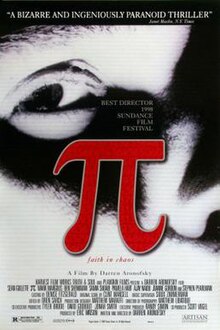
Back باي (فيلم) Arabic Pi (pel·lícula) Catalan Pí (film) Czech Pi (film) Danish Pi (Film) German Pi (película) Spanish Pi (filma) Basque پی (فیلم) Persian Pi (elokuva) Finnish Pi (film) French
| Pi | |
|---|---|
 Theatrical release poster | |
| Directed by | Darren Aronofsky |
| Written by | Darren Aronofsky |
| Story by |
|
| Produced by |
|
| Starring |
|
| Cinematography | Matthew Libatique |
| Edited by | Oren Sarch |
| Music by | Clint Mansell |
Production company | |
| Distributed by |
|
Release date |
|
Running time | 84 minutes[2] |
| Country | United States |
| Language | English |
| Budget | $134,815[3] |
| Box office | $3.2 million[4] |
Pi (stylized as π)[a] is a 1998 American conceptual psychological thriller film written and directed by Darren Aronofsky (in his feature directorial debut). Pi was filmed on high-contrast black-and-white reversal film. The title refers to the mathematical constant pi.[5][6] The story focuses on a mathematician with an obsession to find underlying complete order in the real world and contrasting two seemingly irreconcilable entities: the imperfect irrationality of humanity and the rigor and regularity of mathematics, specifically number theory.[7] The film explores themes of religion, mysticism, and the relationship of the universe to mathematics.
The film received positive reviews and earned Aronofsky the Directing Award at the 1998 Sundance Film Festival,[8] the Independent Spirit Award for Best First Screenplay and the Gotham Open Palm Award.
- ^ McNary, Dave (October 21, 2007). "Summit pins 'Wrestler'". Variety. Archived from the original on November 5, 2021. Retrieved November 5, 2021.
- ^ "PI (15)". British Board of Film Classification. November 3, 1998. Archived from the original on October 19, 2014. Retrieved October 19, 2014.
- ^ "The Pieces of Pi". Filmmaker Magazine. Archived from the original on July 13, 2018. Retrieved February 3, 2019.
- ^ "Pi (1998)". Box Office Mojo. Internet Movie Database. December 4, 1998. Archived from the original on December 15, 2021. Retrieved February 28, 2022.
- ^ Runyon, Christopher (January 13, 2013). "The Darren Aronofsky Retrospective: 'Pi'". Movie Mezzanine. San Francisco. Archived from the original on November 19, 2018. Retrieved January 31, 2017.
Shot in ludicrously grainy, high-contrast black & white
- ^ Anderson, Jeffrey M. (June 25, 1998). "Interview with Darren Aronofsky: Easy as 3.14..." Combustible Celluloid. San Francisco. Archived from the original on December 26, 2016. Retrieved January 31, 2017.
The film is shot in very harsh, gritty, bleak, grainy black-and-white 16mm.
- ^ Skorin-Kapov, Jadranka (2015) Darren Aronofsky's Films and the Fragility of Hope Archived March 18, 2021, at the Wayback Machine, Bloomsbury Academic
- ^ Sundance Stories of Yore: "Pi"|IndieWire
Cite error: There are <ref group=lower-alpha> tags or {{efn}} templates on this page, but the references will not show without a {{reflist|group=lower-alpha}} template or {{notelist}} template (see the help page).
© MMXXIII Rich X Search. We shall prevail. All rights reserved. Rich X Search